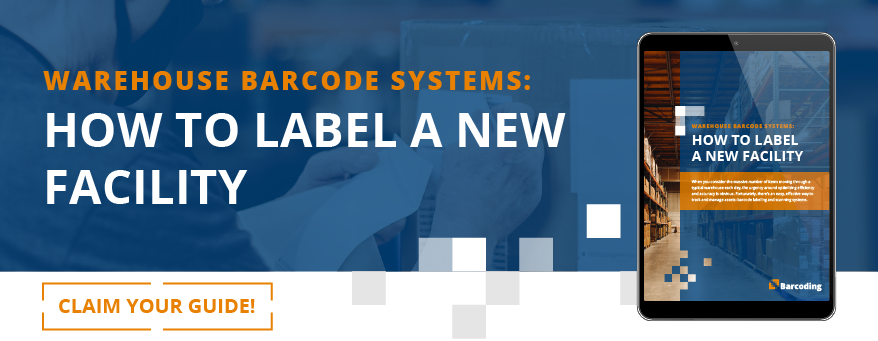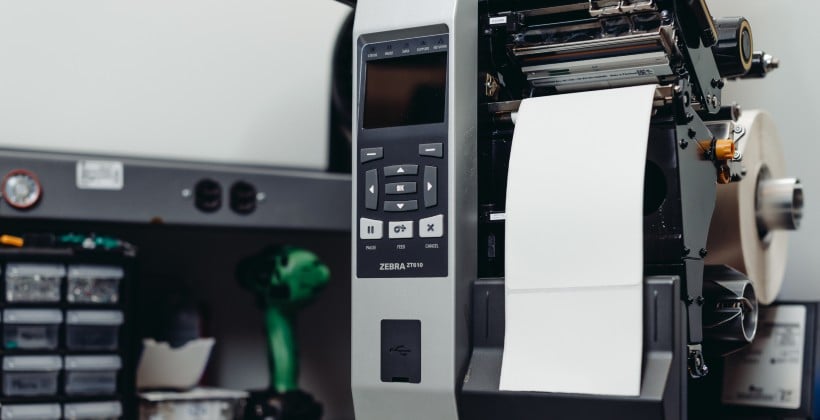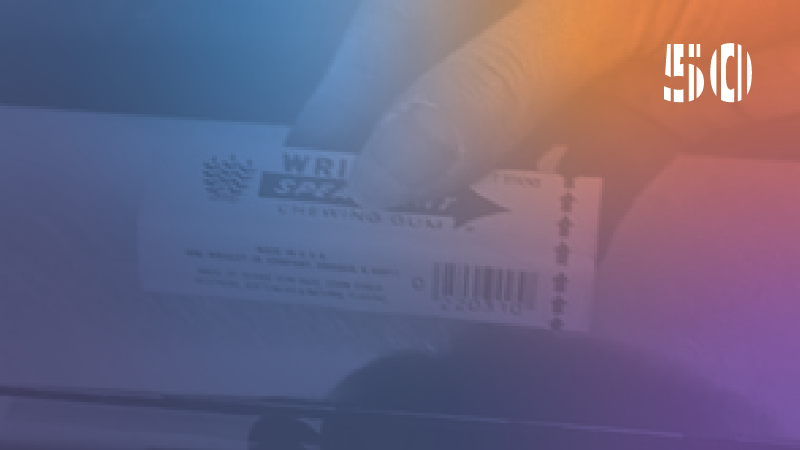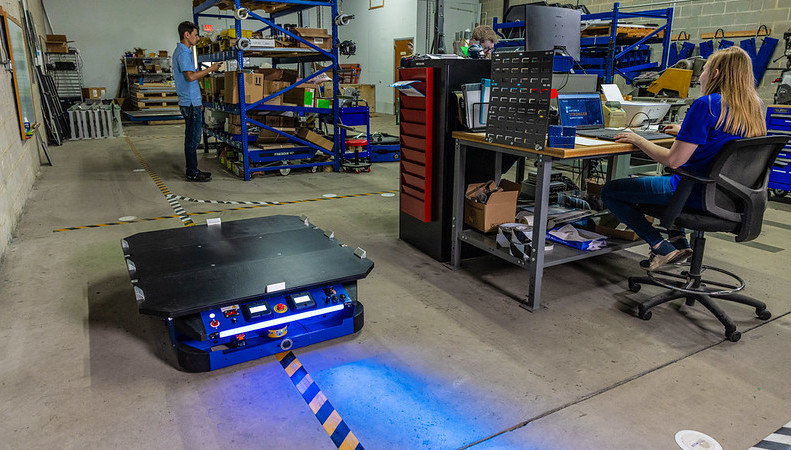Thermal printing is widely used in industrial environments like manufacturing, warehousing and distribution, ecommerce, logistics, and retail.
The printers themselves tend to have fewer moving parts, don’t need liquid inks or powder-based toners, and often last longer and work more reliably than inkjet printers or other printer types.
Thermal printing offers less variety in terms of color than other printing options, but thermal transfer printing is a solid choice for long-lasting items like labels, signs, floor marking, specialty shelving labels, and wire wraps in addition to documents.
The durability of thermal-transfer printed signs and labels means they can withstand harsh and extreme environments. As industries increase their use of barcode labels and scanning technologies, IoT-based technologies like RAIN RFID, robotics, and other automation applications, crisp, clear, durable printed labels have become even more important.
So if thermal printing’s versatility, dependability, and durability are what you’re looking for, the next step is determining which type of thermal printing technology to use — and from there, to select the right type of ribbon for your specific application. Your choice of wax, resin, and wax-resin combinations all present their own best use cases, so let’s take a closer look.
Direct Thermal Vs. Thermal Transfer Printing
Unlike thermal transfer printers, direct thermal (DT) printing relies on chemically impregnated substrates, typically paper-based, combined with heat. The heat-sensitive chemicals added to the paper cause it to darken when exposed to heat, so direct thermal printers utilize small heating elements inside the print head to activate the thermal pigments in the substrate and leave the image or design behind.
These labels are highly sensitive to abrasion, higher temperatures, and UV exposure, so they’re typically used for short-term applications, such as paper receipts, shipping labels, mobile printing, and a few other specific applications.
These printers don’t require ribbons, ink, or toner, making them simple and convenient to use. But at the same time, these labels can be highly sensitive to abrasion, heat, and ultraviolet light (UV) exposure. The printing substrate darkens when exposed to high temperatures.
A thermal transfer ribbon (TTR) provides a more durable image on a broader range of substrates, but it’s important to understand whether you need wax ribbon vs. resin ribbon, or a combination of both.
What is a Thermal Transfer Ribbon, and How Does it Work?
A TTR is made up of clear polyethylene terephthalate (PET) film that’s been coated with a specific combination of wax- and/or resin-based inks and pigments. As the label and ribbon move under the printhead, digital elements on the head are rapidly heated and cooled in order to transfer the ink off the film and onto the label.
The thermal printing ribbon formula you choose depends on your specific application. Many different combinations are available, many specially formulated to print on specific media types, and intended for certain applications.
It’s important to choose the right TTR type to ensure the quality and durability you’re looking for. Generally, you can choose from three types, available for most thermal transfer printers: wax ribbons, wax-resin ribbons, and resin ribbons. Here’s a look at the features of each.
Wax Thermal Transfer Ribbons
Wax ribbons, sometimes referred to as “full wax ribbons,” or “resin-enhanced wax” ribbons, are the most common (and typically least expensive) choice, suitable for uncoated or matte, coated labels.
Durability: Wax ribbons are less durable than other types but are less costly, too. They provide an image that resists fading better than direct thermal labels, but the image is still going to be susceptible to scratching and smudging. Wax ribbons also offer limited chemical resistance compared to wax-resin or resin options.
How the process works: All wax ribbons also have some resin in their formulas. The combination of wax and resin inks are melted down to coat a PET film. A back-coating applies to the reverse side of the film, and the rolls are cut to various widths and lengths for different printer models.
In the printer, the printhead elements receive a digital signal to rapidly heat up and cool down. When hot, they transfer the wax-and-resin ink from the ribbon onto the label. Assuming you have the correct label-ribbon combination, the ink will stick to the label.
Uses: Wax ribbons are used for short term and light-durability applications such as shipping labels, retail tagging, storage locations, signage, and more. They are by far the most popular ribbon type, and make up over 70% of TTR sales.
Wax-Resin Thermal Printer Ribbons
Wax-resin ribbons are made of a blend that comes close to half wax, half resin. They are more expensive than wax ribbons, but offer great print quality along with durability and substrate versatility. They can print on almost all types of label and packaging films.
Durability: Wax-resin is more durable than full wax when it comes to scratch and smear resistance. Wax-resin blends are resistant to moderate-to-harsh chemicals, as well as more extreme temperatures.
How the process works: The process is essentially the same as that of the wax ribbon process. The primary difference is the more or less even split between wax and resin in the ink layer of the ribbon.
Uses: Wax-resin ribbons are used for applications that demand an added level of resistance to abrasion, chemicals, or harsh environments. Some common applications include laboratory labeling, outdoor product or UL labeling, cold-chain labels, or freezer applications where added durability is a must if you don’t want those printed barcodes to deteriorate.
Resin Ribbons for Thermal Transfer Printing
Many resin ribbons still have a small amount of wax in their formulas, but they are mostly pure ink resins, making them the most durable (and most expensive) type of TTR. Resin ribbons are formulated for the most demanding applications, and they are compatible with glossy coated paper labels, synthetic film labels like polypropylene, polyethylene, polyester, or even specialty substrates like polyimide, acrylate, and textiles.
Durability: These are by far the most durable and abrasion-resistant of the three ribbon formulations. Extreme heat or cold, harsh chemicals and solvents, rough abrasives or high-abrasion environments, and even outdoor environments are no match for a properly selected resin ribbon, printed on a carefully selected label stock.
How the process works: The higher the proportion of resin in the formulation, the more energy is required to melt the inks onto the ribbon substrate — and the same logic applies to the printer. It takes more energy to transfer the inks to the print substrate as well, so printhead darkness and speed setting may require some adjustment to achieve the desired image.
Uses: The extreme durability of resin ribbons makes them a requirement for some harsh-environment or mission-critical applications. The wide range of typical uses includes medical device labeling, electrical component/printed circuit board (PCB) labeling, apparel care tags, plant stakes, chemical drum labeling, etc.
Special Considerations
Sometimes, it can be a challenge to choose label substrates, printing technologies, and materials with confidence. That’s the difference an experienced partner can make. Our experts can help you evaluate your needs based on your application, environment, productivity goals, and budget to choose the right printers and materials.
Finally, some label applications demand capabilities that go beyond on-demand print technologies. In those cases, Barcoding’s strategic partnerships with major converters make it easy for our customers to have labels produced to virtually any specification. We streamline production of preprinted labels, even with specialty finishes like clear lamination for extra protection against abrasion, UV exposure, and/or chemicals.
We also help customers that need to create specialty barcode labels on anodized aluminum, via laser etching on steel for the extreme durability, and even on ceramic substrates for the ultimate in heat resistance.
Thermal transfer printing and the wax, resin, or wax-resin combination ribbons they require represent one small but significant part of an effective barcoding system. Choosing the right printer and ribbon combination can make a major impact in productivity and efficiency. Learn more about the difference proper labeling can make in a warehouse, distribution center, or other industrial facility when you download our free guide. Just click here or below to get yours today.







